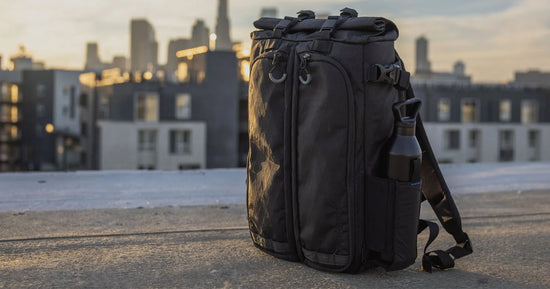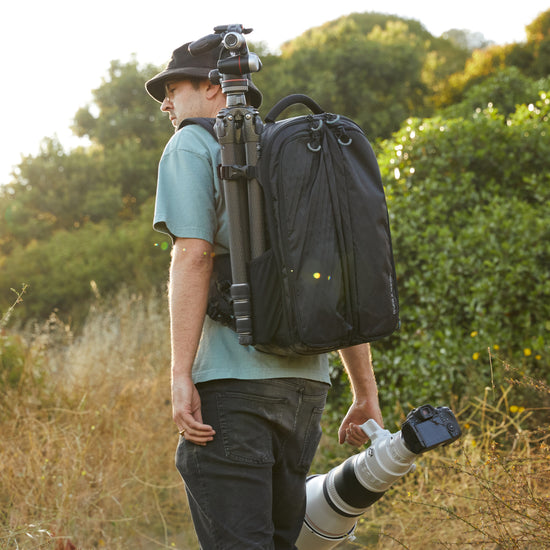Joshua Holko is a an award-winning full-time nature photographer based in Melbourne, Victoria, Australia. We sat down with him to discuss his beginnings in photography, his inspirations, and what draws him to the polar regions.
Joshua, how did you got started in photography?
I’ve been photographing since I was a kid. My dad was an amateur landscape photographer. I’d follow along and carry the tripod for him and that’s where I got my first interest in photography. Then, I started photography when I left for school. I did a degree in fine art photography and a diploma in photojournalism. After school, I spent some time in the corporate world and didn’t become a full-time photographer until I was in my mid to late thirties. I was still shooting on the weekends and pursuing it as a passion, shooting what I wanted to shoot while working my corporate job though.
Oh. That’s so interesting to have a father who was a photographer. I’m sure he still inspires you. Who are some of the other photographers who inspired you early on?
I’ve always been a really big collector of photographic books. I get inspired by looking through them. And, there are certainly photographers. I get inspired by a broad range of photographers’ work. I think that’s how we grow as artists as well. Thinking back, obviously, I was influenced by some of the greats at the time; you know Ansel Adams and people like him. But, contemporary photography actually interests me more. So some of the photographers around today, for example, the French wildlife photographer, Vincent Mounier is one of my stronger influences.
He’s an interesting photographer as it looks like he’s successful at shooting so many genres. Moving over to your website, there’s quite an extensive list of places you’ve been. Which were some of your favorites and why?

I tend to specialize in polar photography. That’s really my genre so most of the year I’m in the north, in the Arctic, or I’m in the south in the Antarctic. And, they’re two very different places. They’ve got a very different feel about them. Antarctica is probably the more romantic of the two and it’s kind of like visiting another planet because it’s so hard to get to. It takes so long to get there via ship. And, there’s just a plethora of wildlife there so you know there are penguins, seals, whales and the wildlife is really easy to find. It’s a very special place.
Then, you have the Antarctic where you’ve got polar bears and arctic foxes. These animals are no less beautiful and perhaps even more so, but they’re incredibly difficult to find. There’s much more of a struggle for life, so the regions are very very different. It’s hard to say which one is my favorite of the two. I love them both equally.
I’m also a big fan of Finland. I think Finland is one of the most underrated destinations for wildlife photography today because it has so much to offer. You have wolves, wolverines, bears, eagles, fantastic birds. It’s just a wonderful place to photograph. In fact, all of the Scandinavian countries whether it’s through Norway, Sweden. The top end of Norway up in Svalbard where you’ve got polar bears, reindeer, arctic foxes. They’re all fabulous places, but all very very different.
I heard you discuss being drawn to the polar regions due to their quality of light. Could you describe the quality of light and what makes it different for our audience?
What attracted me to the Arctic, photographically, is you have this thing called the midnight sun where in the peak of summer the sun doesn’t set; it's just going around and around because you’re so far north or so far south. But, what happens on the cusp of the seasons is that the sunrise or sunset can last three or four hours. And that is just an amazing time for photography because you’ve got great light for hours.
By contrast, here in Australia, sunrise and sunset can last a few mere moments. Maybe it’s two minutes, so you don’t have a lot of time to work in that really sweet light that you get in these far north and far south regions. That was a huge attractor for me. The first time I experienced it, it just changed everything to be able to photograph in such great light. It gives you a lot of opportunities. That was a huge driving factor for me to fall in love with these areas.

How did you end up specializing in the Arctic? We talked about the light, but is there anything else that draws you there?
They’re just so extreme in every sense especially the weather. I also love minimalist photography and that white landscape really gives me that canvas to work in. Combine that with great light and I was hooked.
I can imagine! As you’re describing it, I envision so many opportunities to capture something that’s not only beautiful, but very unique. Also, it must be really special to experience just being there. So coming over to your portfolio, there’s a pretty good distribution of landscapes and wildlife. Is there one that you’re more drawn to photographing?
I call myself a nature photographer, but these days I much more consider myself a wildlife photographer. A big part of the reason I’ve shifted over the years has been the explosion in photography and social media. I started to see, mostly in social media, the same places being photographed over and over again. And, I thought, “This just comes down to whoever was there in the best light. There’s no real skill in this anymore.”
The tools make it so easy. I could stand in a long line on the edge of a waterfall taking the same picture as everyone else and whoever had the best light would have the best photograph. So, I decided to make the shift into wildlife where not only do you have to find the animal, but you have to find the animal doing something interesting. And, that’s impossible to replicate because the gesture will never be the same and the environment will never be exactly the same. So I moved into wildlife because I was just starting to photograph places that people had already photographed and that felt like repetition to me for the sake of it.

If I take a photograph of a wild wolf on the border of Finland and Russia with a salmon head in its mouth, no one else will have that same photograph. And honestly, I think wildlife photography is harder. I’ve always said you need three things to make a great photograph: you need a great subject, you need great light and you need great composition. Now, a great subject you can find, but if you add wildlife into the mix, then the subject also needs to be doing something interesting so it adds a fourth element. We don’t need another head and shoulders shot of a wolf or a lion; there’s a zillion of them. But, if you can get a photograph of an animal doing something interesting, then it’s special. And that as I said becomes unique so that really became a big factor in my switch from focusing on wildlife from landscape photography. Now having said that, I still do shoot a lot of landscapes and I still do enjoy it very much, but I don’t really shoot iconic landscapes much anymore.
Joshua, that’s going to give us a lot to think about in terms of creating great photography. Thanks so much for sharing your insights with us today.
Cheers. I look forward to talking again soon.
Follow the Gura Gear Journal for more conversations with professional photographers. We’ll be providing valuable insights into how they plan, shoot and process their images.
Is there a topic you want us to cover? Let us know by sending an email.
To see more of Joshua’s work, visit his website here.
When working in these challenging environments, Joshua only takes the best camera bags with him, which you can shop for here.





